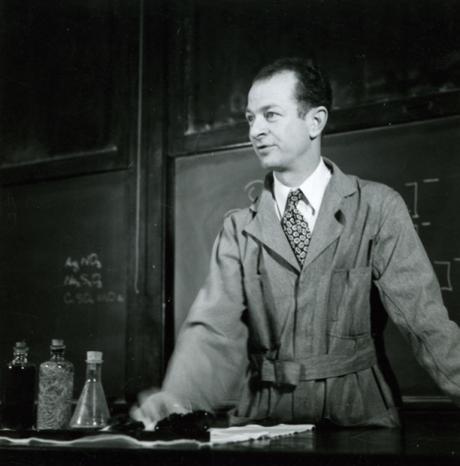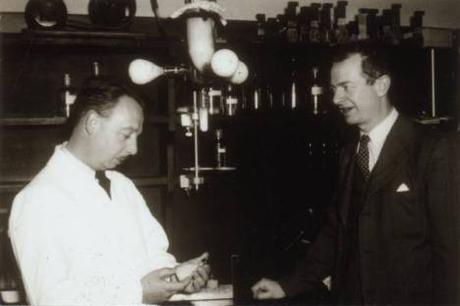
Linus Pauling, 1935
[Part 1 of 6]
Today, Linus Pauling is most commonly known for unraveling the chemical bond, working for peace, and promoting vitamin C. However, this short list barely scratches the surface of Pauling’s work in any number of fields. Beginning today, we will explore a lengthy program of research that Pauling oversaw on the serological properties of simple substances, a title that he appended to fifteen publications authored from 1942 to 1949. Post one in this series will focus primarily on Pauling’s background in biology and the work that led up to his first set of serological publications.
One of Pauling’s first major forays into the world of biology came about through his study of hemoglobin, the molecule responsible for transporting oxygen in the blood. Specifically, in 1934, he launched a study hemoglobin partly as a means to begin a larger inquiry into the structure of proteins.
An investigation of hemoglobin, Pauling quickly decided, would require more than one year to obtain results. Consequently, in November 1934, he applied for a grant from the Rockefeller Foundation to “support researches on the structure of Haemoglobin and other substances of biological importance.”
At the time, the Rockefeller Foundation was keenly interested in funding studies of “the science of life,” and Pauling’s grant request was promptly approved, with the first injection of funds received in July 1935. Although Pauling had originally intended for the grant money to go specifically toward his work on hemoglobin, as he corresponded with his funders he expressed an openness to studying other “interesting biochemical problems,” and indeed this quickly became the case.
A few months later, in 1936, Pauling met Karl Landsteiner, whose ideas would help to shape the course of Pauling’s research for the next several years. Landsteiner was an Austrian biologist and physician best known for discovering the human blood groups. By the time that he met Pauling, he was also actively engaged with topics in immunology.
Over the course of their conversations, Landsteiner passed this interest on to Pauling, who became fascinated by the specificity of antigens (foreign substances that enter into the body) and antibodies (proteins that neutralize antigens and prevent them from causing harm). The human immune system is capable of building thousands of antibodies, each of which reacts with a specific antigen. This specificity is seen in few other physical or chemical phenomena. However, one area in which it is found is crystallization, an area of chemistry with which Pauling was very familiar. This body of knowledge set Pauling down a path to making important contributions to the study of antigen-antibody behavior.
As he sought to learn more, Pauling read Landsteiner’s recently published book, The Specificity of Serological Reactions, finishing it shortly after their initial meeting. The following year, 1937, Pauling and Landsteiner met again and spent several days discussing the most current ideas in immunology. For Pauling, immunology presented two particularly compelling questions: First, what were the forces that enabled the combination of an antibody and its homologous antigen, but no other molecule? Second, how were antibodies produced and how did this means of production allow antibodies and antigens to combine so specifically?

Dan Campbell and Linus Pauling in a Caltech laboratory, 1943.
In 1939, Pauling decided to shift the bulk of his research focus to the interaction dynamics of antigens and antibodies. As his work moved forward, Pauling came to theorize that the specificity shown by antibodies when combining with antigens depended on how well-matched the shapes of the two molecules were, a theory called molecular complementarity. In other words, antibodies and antigens were able to come together because their shapes complemented one another, like a hand in a glove.
From there, Pauling developed a plan to perform a broad range of experiments that would, he hoped, strengthen this theory and prompt it forward as the accepted explanation for the specificity of serological reactions. To assist in this promising line of inquiry, Pauling hired Dan Campbell, at the time a research fellow at the University of Chicago, to come to Caltech and serve as the Institute’s first faculty member in Immunochemistry. Campbell arrived in January 1940 and remained at Caltech until his death in 1974.
Once relocated to Pasadena, Campbell starting out by working on structural studies of hemoglobin – Pauling’s old research project dating back to 1934. A few months later however, a key shipment of serum antigens arrived from Karl Landsteiner’s laboratory, and both Campbell and Pauling began experimenting on the issue of the day. Initially, the duo encountered only disappointment as they uncovered no results of interest. However, the early setbacks did not stop Pauling. He persevered and, in October, published a landmark article, “A Theory of the Structure and Process of Formation of Antibodies,” which detailed his ideas on molecular complementarity.
In 1941, Pauling began an experimental program on serological reactions focusing on simpler organic compounds whose structure he already knew. In so doing, he also began to add more collaborators. Besides Campbell, the first of these was David Pressman, who earned his doctorate under Pauling and then stayed on at Caltech to support the nascent immunology program until finally leaving in 1947.
In addition to the simple substances work, this trio of researchers also continued other lines of study pertaining to Pauling’s antibodies projects. In early 1942, one of these produced what seemed to be an incredible result: that March, through a press release rather than a conventional journal article, Pauling, Campbell and Pressman announced that they had created artificial antibodies. A wide array of newspapers and magazines picked up the story and interest rapidly grew. However, other scientists could not replicate the trio’s results and skepticism of the group’s claim began to mount. Pauling, however, continued to believe that his team had truly created artificial antibodies, though subsequent efforts found only dead ends.
Undaunted, Pauling continued his experiments on serological reactions in simple substances and, in December 1942, published the first four papers of what would ultimately become a fifteen-paper series. This body of scholarship was the culmination of several years of work conducted by many people including Pauling, his two main collaborators, David Pressman and Dan Campbell, as well as one other non-student colleague. Several graduate students also supported the effort by helping to prepare the necessary compounds and running the experiments; as the publication series ran its course, eight were eventually listed as co-authors. Three graduate students, Carol Ikeda, Miyoshi Ikawa, and David H. Brown, were involved in the first four papers. Beginning next week, we will take a closer look at the details of what this group published.
Advertisements